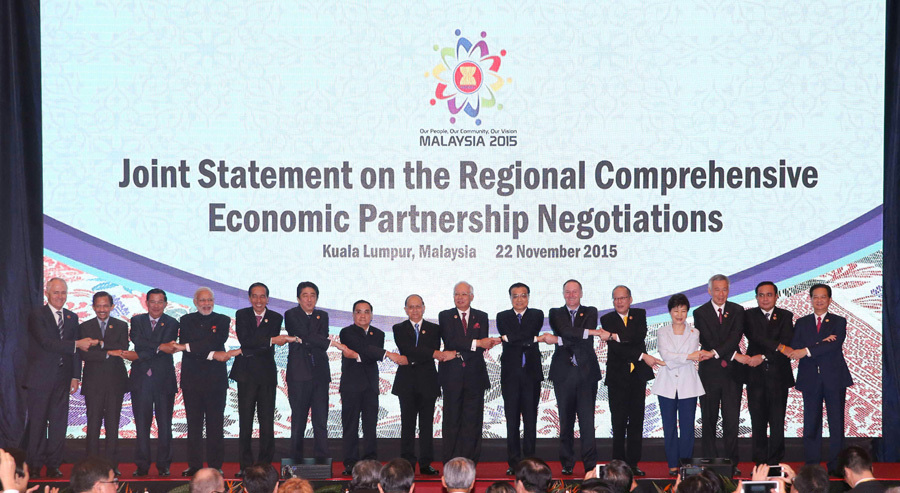HAN LIQUN: RCEP provides alternative pathway toward regional cooperation in Asia

On the morning of November 22 local time, Premier Li Keqiang attended in Kuala Lumpur Convention Centre the issue ceremony of the Joint Statement on Regional Comprehensive Economic Partnership (RCEP)Negotiations. Leaders from the 10 ASEAN countries, and the Republic of Korea (ROK), Japan, Australia, New Zealand as well as India together attended the ceremony.
If everything goes as planned, the ongoing negotiations on the Regional Comprehensive Economic Partnership (RCEP) will be completed by 2016, marking another step toward the integrated development of the Asian economy.
It has been three years since the negotiations on the regional trade agreement began, and the global landscape has changed significantly. New breakthroughs are needed to promote regional economic cooperation.
First of all, Asia’s breakneck growth is starting to slow against the backdrop of a sluggish world economy. The lingering effects of the global financial crisis are undoubtedly to blame. Also, some factors in the progress of globalization should not be neglected.
In the past 10 years, the Asian economy, especially that of East Asia, grew rapidly as transnational corporations globalized production. These giant conglomerates focused on the horizontal division of labor, transforming value chains into production networks. Much global wealth was created in this phase, and East Asia became increasingly specialized, forming effective regional production networks. The dividends of globalization thus helped push forward rapid economic growth in this region.
Globalization has its own laws of development. As international production networks grew increasingly mature, economic and trade growth inevitably slowed down.
From the 1960s to the beginning of this century, East Asia overcame the flying geese paradigm, resulting in the creation of production networks. It was still restricted by external demand and the production layout of transnational corporations amid high growth. Emerging and developing Asian countries have been eager to move up the global value chain. Therefore, future cooperation should be conducted based on the development of globalization, leading to a more balanced and mature regional economic structure.
Despite slow growth, the development of institutions may come to more closely reflect the economic structure, and countries will be motivated to participate in regional cooperation.
After China’s accession to the WTO, capital, resources, technology and personnel from Asia and other parts of the world flocked to China, which then became the center of regional production networks. China and Japan acted as East Asia’s main producer and consumer respectively. Regional cooperation should have centered on the two countries. However, influenced by such factors as geopolitics, ASEAN became the focus of institutional cooperation in East Asia. This resulted in dissociation between institutional construction and economic structure. Economic integration in East Asia thus lagged behind comparable processes underway in Europe and North America.
Around 2013, the Chinese economy gradually shifted to the “new normal.” China became the new center of the East Asian economy, providing a solid economic foundation for a regional cooperation mechanism centered on ASEAN. This is a partial solution to the disjuncture between institutional construction and economic structure in East Asia.
Furthermore, the completion of negotiations for the Trans-Pacific Partnership (TPP) has had a significant impact on Asian economic cooperation.
Before the TPP negotiations concluded, there were a number of strategies for regional cooperation in the Asia-Pacific region, but countries not covered by the agreement are now concerned about their economy and security.
Actually, the influence of the TPP at the institutional and economic level remains to be seen, and there are limitations to what it can achieve. In addition, member countries need to pay enormous costs to form new economic networks and reshape the value chain.
Compared with other parts of the world, the Asia-Pacific region faces great obstacles to economic cooperation posed by geopolitics. In fact, the political situation in East Asia has remained tense over the past two decades. However, this cannot hold back regional cooperation. Leaders in this region want to set aside geopolitical disputes to push forward regional cooperation. The proposition of the RCEP shows wisdom, and ASEAN has created space once again for regional economic cooperation. In the current security situation, all member countries still have strong political aspirations to advance regional economic cooperation.
This article was translated from Outlook Weekly. Han Liqun is from the Institute of World Politics at the China Institutes of Contemporary International Relations.
